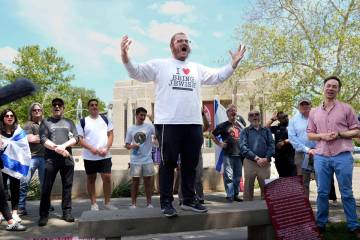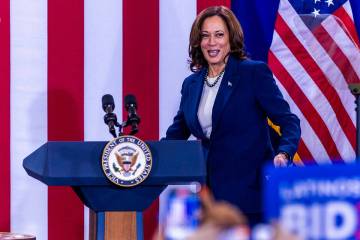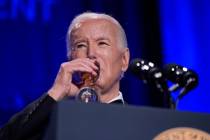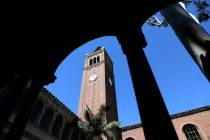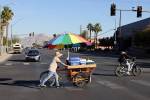City panel backs 300-foot buffer between food trucks, restaurants
The fight to protect Las Vegas restaurants from mobile food trucks that could poach their customers has divided City Council members who are struggling to agree on the appropriate size of a buffer zone.
On Tuesday, members of the City Council's Recommending Committee floated three different proposed distance buffers before voting 2-1 in favor of creating a 300-foot zone between food trucks and existing restaurants.
Mayor Pro Tem Stavros Anthony and Councilman Ricki Barlow voted in favor, Councilman Bob Coffin voted against. Coffin had proposed an 800-foot buffer zone, but Anthony and Barlow voted it down.
The vote advances the proposed buffer zone, and a raft of other regulatory changes, to an Aug. 15 meeting of the full council, which could approve, deny or amend the proposal yet again.
The vote followed more than an hour of debate at the recommending committee where restaurant owners made impassioned pleas for an 800- or 1,000-foot buffer zone they said would protect their businesses.
Bar + Bistro restaurant owner Wes Isbutt, who also uses the surname Myles, said not only should the distance between food trucks and restaurants be greater, but the buffer zone should apply to special events too, meaning trucks shouldn't be able to park directly outside an event organized by someone else.
"When the food trucks are allowed to, and I am sorry for using this term, to pillage on or to leech on other events that are going on, it is an unfair playing field," Isbutt said.
Camy Silva of El Gaucho Luca's Cafe said food trucks near the Regional Justice Center intercept customers who might otherwise go to her restaurant at 231 S. Third St.
"I'd like it to be about 1,000 feet," Silva said. Customers "are not going to walk one block to my restaurant; they are just going to grab whatever they are selling on the truck."
Although the ordinance would create a buffer zone between restaurants and food trucks in the public right-of-way, food trucks could operate on the property of a licensed business even within a restaurant buffer zone.
The debate over whether to regulate food trucks to protect restaurants has been going on for about a year.
Restaurants accuse mobile vendors, which in recent years have leveraged more creative food offerings and Facebook, Twitter and other social media to become a trendy option in the urban dining scene, of swooping in to skim customers from restaurants when foot traffic in an area is heavy and leaving them with the burdensome costs of operating in a fixed location.
In March, the staff in the planning department recommended an update to vending regulations that included a 150-foot buffer.
When the proposal reached the Planning Commission, however, commissioners voted 3-2 to change the buffer to 1,320 feet in response to pleas from restaurants.
After the commission vote, food truck operators said the distance was too great, and no one on the council would agree to sponsor the bill.
Mayor Carolyn Goodman agreed to become the sponsor but only at the 150-foot distance.
After the recommending committee bumped the distance back to 300 feet, Goodman said through a spokeswoman "it would be premature to comment" on the proposed distance until the council meets in full to discuss it.
After restaurant owners spoke at the recommending committee meeting, Coffin recommended an 800-foot buffer zone, noting the proposed new requirements still include 1,000-foot buffers for concession stands in city parks.
"So I don't know why then we should just permit these privately owned businesses to have to compete with somebody 150 or 200 feet away," Coffin said.
Anthony said the 800-foot buffer was too far because it would keep the trucks from operating anywhere close to the busy downtown thoroughfares.
"That is a statement that we don't want the food truck vendors downtown," Anthony said. "I don't believe that should be the case."
Barlow proposed the 300-foot buffer, which got Anthony's support but not Coffin's.
Douglas Porter, owner of the Curbside Cafe food truck, said he supported the 150-foot buffer and probably wouldn't be hurt by the 300-foot buffer, but he added that increasing the distance does have the potential to hurt Las Vegas' burgeoning food truck scene by making it difficult for the trucks to set up shop near areas bustling with foot traffic.
"The reason we want to be there is not the restaurant, it is the other activity in the area," said Porter, who operated a restaurant for 10 years before going into the food truck business.
Porter also said restaurant owners who claimed food trucks are unclean, unregulated or responsible for restaurants' difficulties are incorrect.
"They want to blame food trucks for their problems, and that is just not accurate," Porter said.
Contact reporter Benjamin Spillman at bspillman@ reviewjournal.com or 702-383-0285.
Map of proposed buffer zones between downtown restaurants, food trucks






